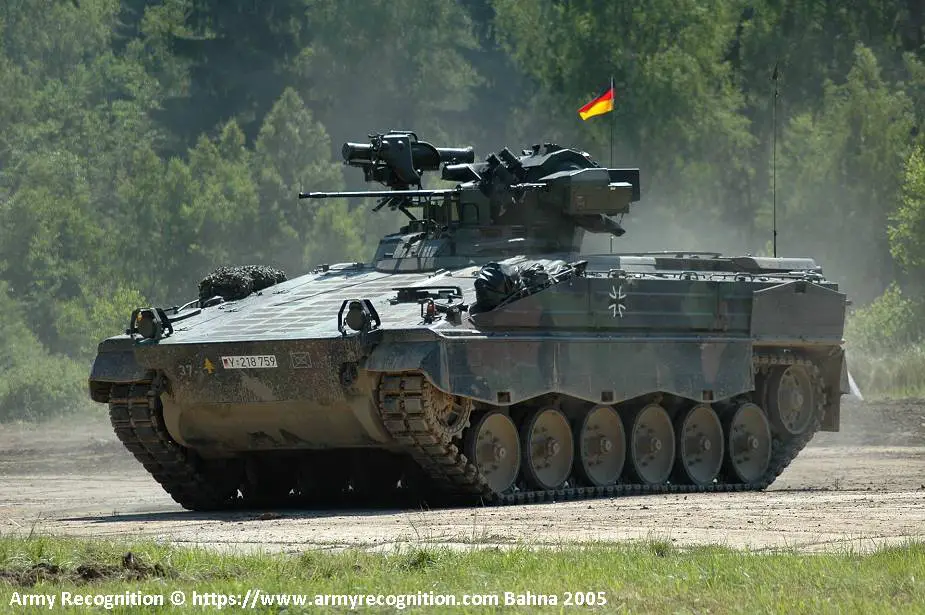Breaking news
Delivery by Germany of 100 Marder tracked armored IFVs to Ukraine still under discussion.
According to information published by the German newspaper website "Bild" on May 14, 2022, Germany continues to discuss an option to deliver 100 Marder tracked armored IFVs (Infantry Fighting Vehicles) to Ukraine, despite the German parliament suspending the decision.
Follow Army Recognition on Google News at this link

German army Marder 1A3 tracked armored IFV Infantry Fighting Vehicle. (Picture source Army Recognition)
Several weeks ago the German Minister of Economy Robert Habeck and the Minister of Foreign Affairs Annalena Baerbock, both members of the Security Council had given their agreement to deliver 100 Marder tracked armored Infantry Fighting Vehicles (IFVs) to Ukraine.
On April 26, 2022, Germany approved the delivery of Gepard's 35mm self-propelled anti-aircraft mobile gun systems to Ukraine but today, the Swiss company which produces the ammunition for the Gepard has not received authorization from the Swiss government for the export of this ammunition.
At the end of February 2022, the German company Rheinmetall had offered to deliver 100 Marder IFVs to Ukraine, as well as the ammunition necessary for the use of the vehicle.
Currently, a total of 710 tracked armored IFVs are in service with the German army including 305 Marder 1A3/A4, 71 Marder 1A5, and 334 Puma. According to our sources, German company Rheinmetall could deliver Marder 1A3s from the German army military inventory.
The Marder is a German-made tracked armored IFV that were delivered to the German army in 1968 and the first vehicles were handed over on May 1971. During the last decades, the Marder has undergone several modifications and modernizations in order to respond to new threats on the battlefield. In its latest versions, including the 1A3 model, it remains an excellent modern combat armored vehicle combining mobility, protection and firepower.
The Marder 1A3 is an Infantry Fighting Vehicle, the all-welded steel hull of the provides protection against the firing of small arms fire and artillery shell splinters, with the front of the vehicle giving complete protection from 20 mm Armor-Piercing Discarding Sabot (APDS) projectiles. The 1A3 version is fitted with a new passive armor package providing protection against penetration from the Russian BMP-2 30 mm cannon.
The Marder 1A3 is fitted with a two-man turret with the commander on the right and the gunner on the left. The main armament of the vehicle consists of one 20 mm Rheinmetall MK 20 Rh202 automatic cannon. The second armament of the Marder 1A3 includes one 7.62 mm coaxial machine gun MG3 mounted to the right of the main armament. Two banks of three electrically operated 76 mm smoke grenade dischargers are mounted between the coaxial machine gun and the gun. On the right side of the turret, there is also a MILAN anti-tank guided missile launcher station operated by the commander with one missile ready to fire and six inside the vehicles. The latest generation of MILAN missiles has a maximum range of 3,000 m.
The Marder 1A3 has a crew of three including a driver, commander and gunner and the rear part of the vehicle can accommodate up to six infantrymen. is motorized with an MTU MB 833 Ea-500 6-cylinder liquid-cooled diesel developing 600 hp at 2,200 rpm coupled to a 4-speed HSWL 194 planetary transmission with 4 forward and 2 reverse gears and integral steering and braking system. It can run at a maximum road speed of 65 km/h with a maximum cruising range of 500 km.
The suspension of the 1A3 variant of the Marder features a number of modifications including the installation of reinforced torsion bars, a hydraulic duplex brake system, change of gear ratio of the lateral final drives to maintain high mobility, steering agility and acceleration.




























